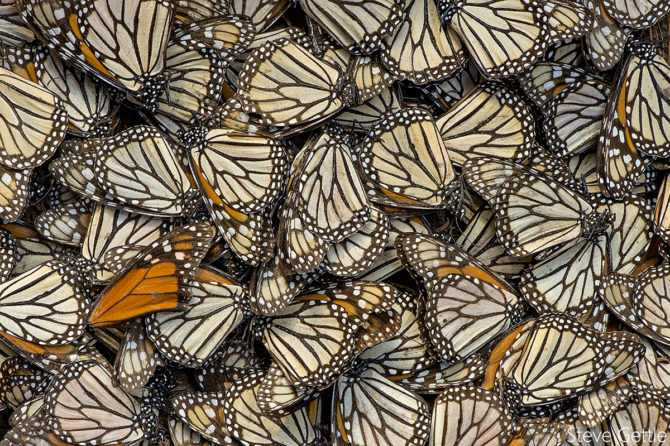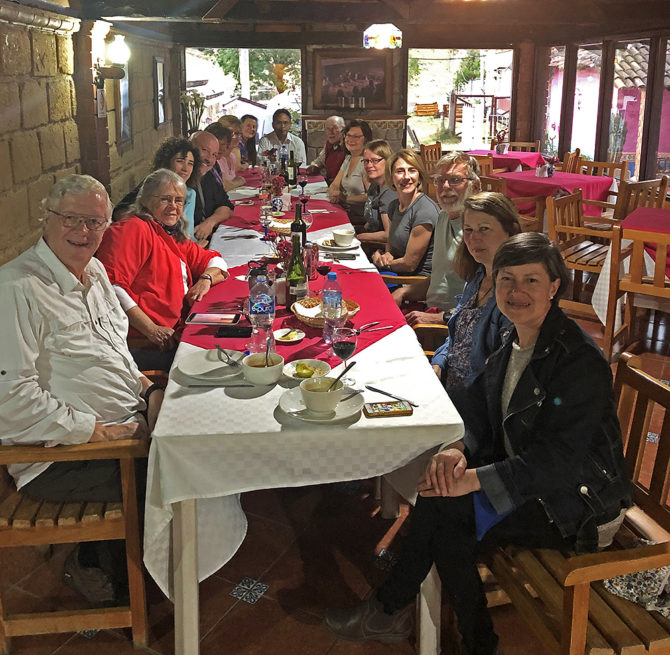
These are the Monarchs that flew from our yards last fall, traveling 3000+ miles, to overwinter in Mexico before returning north this spring to lay eggs and pass the baton to the first generation of 2019.
We had a great group made up of naturalists and photographers alike, coming from all across the country – Illinois, Kentucky, Virginia, Michigan, Louisiana and New York. In addition to the two of us we also arranged to have Estela, the lead person on the ground in Mexico for Journey North, with us as our guide throughout the trip. Her in depth knowledge of local customs and history as well as her many connections at the sanctuaries was invaluable.
This was the first of our “weekender” experiences where we take a short flight to a cool destination and essentially make a long weekend out of it.

Over the course of our trip, we visited the three main Monarch colonies. The first that we visited was El Rosario and it did not disappoint. With warmer temperatures this year, the Monarchs were roosting lower on the mountain than they ever have. So, after passing through the sanctuary gates, we started our ascent by walking up the trail and almost immediately started seeing them.

First, we saw a few Monarchs nectaring on asters and other wildflowers, then more came streaming down the trail until finally we saw the roosts: clusters of millions of Monarchs hanging heavy on Oyamel fir boughs. Without warning, they erupted from the boughs, filling the sky and forest with flashes of orange. As we stood in their midst, the rustle of their wings filled
the air. It was wonderful!
This year was important: the Monarch butterfly population has been on a serious decline since 1996 but last year, conditions were good for milkweed – the only plant Monarchs lay their eggs on and the only food they eat as caterpillars. Temperatures throughout the season were “normal”, there were no major weather events and the Monarch population to soared by 144%.

When they arrived in Mexico last November, Monarch numbers exceeded 300 million. They covered 6.05 hectares – the highest in over a decade. While one good year does not create a trend, it is a step in the right direction and we really enjoyed them! We spent the whole day at El Rosario, engulfed in the magic of this migration and drive to pass on life.
One thing that struck us as we stood in this midst of all of these Monarchs was that because the majority of Monarchs had come to El Rosario this year, we were witnessing not only the incredible numbers of live Monarchs but also the greatest mortality. The challenge of the migration and the struggle to survive was apparent.

Each winter is a dance for survival on a razors edge. Since Monarchs feed very little during this time, they must have enough fat reserves from the fall migration as well as water at the overwintering sites to carry them through the winter. They don’t always win this delicate balancing act and many are lost each year to starvation and bad weather.

The next day, we headed to Sierra Chinua. One of the fun things about visiting the Monarchs in this location is that they are best reached via horse. So we made arrangements for all is us to have a horse as well as a handler to guide the horse along the trail. From a nice mounting station, it was easy to board our horses and go on our ride of about 20 minutes to reach the roosts.
Once there, we walked down the hill to the forest area where Monarchs were roosting. We arrived at about 10:30 am and the sun had yet to reach the roosts but as the warmth poured in, Monarchs started to stir and soon the clusters broke loose and Monarch were flying all around us. Again, we saw eruptions from the boughs, brilliant orange against the dark green pines and firs.

We enjoyed the day, seeing Monarch mating and starting this last chapter of their lives in this relay of life. The sanctuary guides watch over the Monarchs through the season and they told us that the Monarchs had started depart about a week ago, which is historically the earliest ever. Even with an early departure there were still overwhelming numbers of monarchs for us to enjoy.
It is an incredible journey that this last generation of the season makes to carry on their species, living 9 months, flying as many as 3000 miles to reach these mountains, and finally to mate and make a final journey north of at least 500 more miles to reach Texas just as milkweed is coming up. It is such a delicate dance and we were in the midst of it, witness to the last chapter of their lives.
As the afternoon pressed on, it was time to mount our horses and head back down the mountain.
Something special about this trip was that this night was also the beginning of the “Farewell to the Monarchs” celebration held by the townspeople in Angangueo. Residents came to the central church for music, dancing and other celebrations. This celebration is held each year as the Monarchs depart and we felt very lucky to be able to be a part of it.

On our last day, we headed to Cerro Pelon. As with Sierra Chincua, we arranged to have horses take us up to reach the Monarchs. As we headed up the hill, we reached an opening in the forest where we could sit against the hillside and watch the Monarchs at the tops of the trees. Later, we walked down into the valley and stood in midst an amazing river of Monarchs and stood breathless as they flowed past us in search of water and wildflowers to nectar upon.

As we wrapped up the trip, we enjoyed our farewell dinner and reflected on the trip. The future of the population flies with these Monarchs and we were there with them!
In coming months when we see Monarch butterflies flying through our own gardens, nectaring on our plants, perhaps laying eggs of their own on milkweed that we planted for them, we will know that we were a part of this relay of life, that the butterflies that we see in our yards are the grandchildren and great grandchildren of the Monarchs we encountered in Mexico and that their migration and the last leg of their journey north was successful. It is humbling to be a part of this drive of life and the magic of this incredible migration.
Will we return next year? Absolutely! If you are interested in joining us, visit our Magic of Monarchs trip page here. https://stevegettle.com/tour/the-magic-of-monarchs/
To track the Monarch migration this spring and fall, check out Journey North. You can even enter your own sightings! https://journeynorth.org/monarchs
And, to learn more about Monarchs, the great migration and how you can help the population, check out Monarch Watch. https://www.monarchwatch.org/